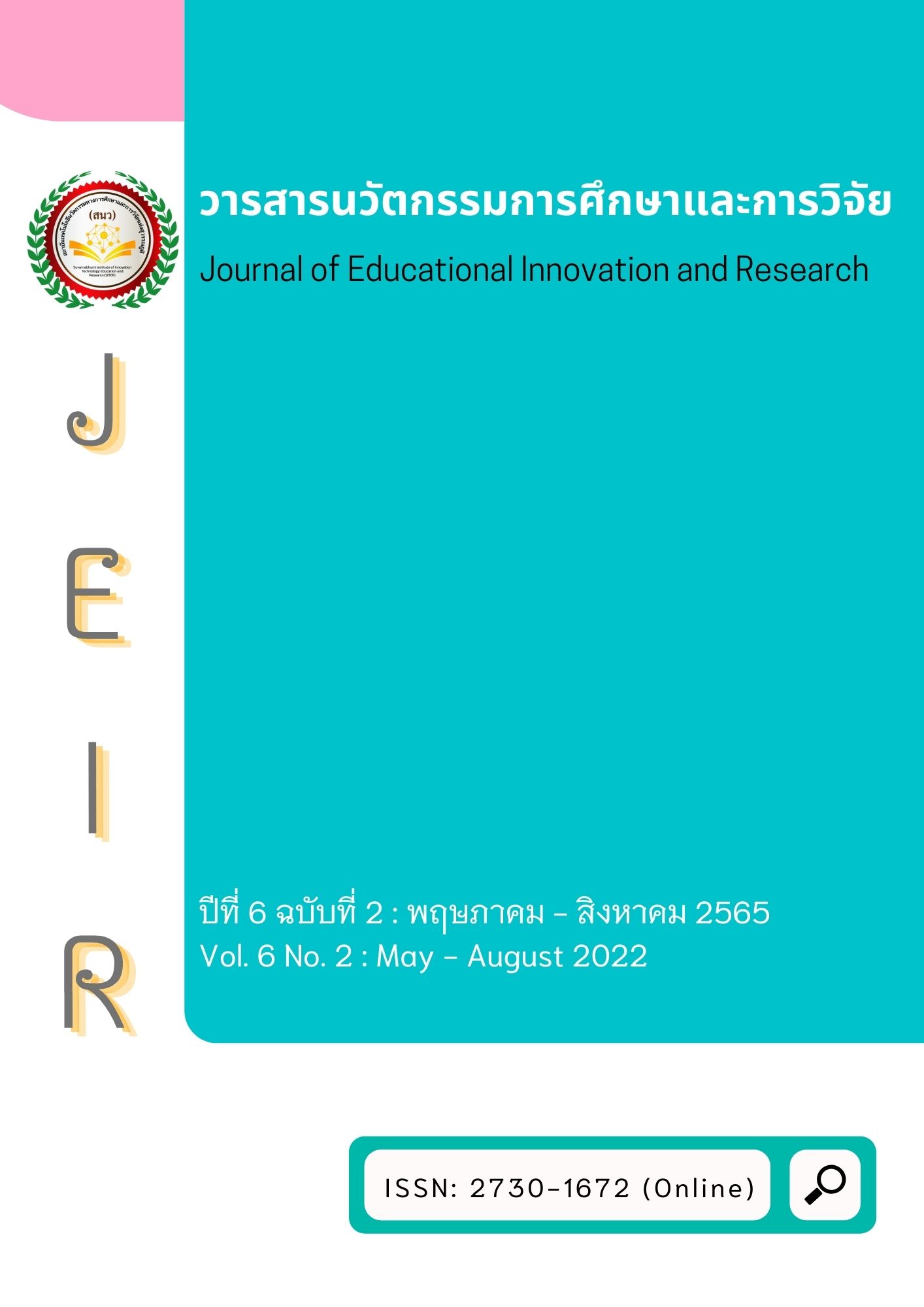โมเดลสมการโครงสร้างความพึงพอใจและความภักดีต่อตราสินค้าน้ำแข็งโชคเอนกของลูกค้าในเขตหนองแขม กรุงเทพมหานคร
Main Article Content
บทคัดย่อ
งานวิจัยเรื่องโมเดลสมการโครงสร้างความพอใจและความภักดีต่อตราสินค้าน้ำแข็งโชคอเนกของลูกค้าในเขตหนองแขม กรุงเทพมหานครครั้งนี้มีวัตถุประสงค์ 1. เพื่อตรวจสอบความสอดคล้องของโมเดลสมการโครงสร้างความพึงพอใจและความภักดีต่อตราสินค้าน้ำแข็งโชคเอนกของลูกค้าในเขตหนองแขม กรุงเทพมหานครกับข้อมูลเชิงประจักษ์ และ 2. เพื่อศึกษาอิทธิพลทางตรงที่ส่งผลต่อความภักดีต่อตราสินค้าน้ำแข็งโชคเอนกของลูกค้าในเขตหนองแขม กรุงเทพมหานคร รูปแบบการวิจัยเป็นการวิจัยเชิงปริมาณใช้แนวคิดการวัดความพึงพอใจของ ACSI และ ECSI เป็นกรอบการวิจัย พื้นที่วิจัย คือ เขตหนองแขม กรุงเทพมหานคร กลุ่มตัวอย่าง คือ กลุ่มลูกค้าร้านขายของชำ ร้านน้ำ ร้านอาหาร และร้านดอกไม้ จำนวน 300 คน ใช้วิธีสุ่มกลุ่มตัวอย่างแบบมีระบบ เครื่องมือที่ใช้ในการวิจัย คือ แบบสอบถาม วิเคราะห์ข้อมูลโดยใช้ สถิติพื้นฐานค่าเฉลี่ย ร้อยละ ส่วนเบี่ยงเบนมาตรฐาน และการวิเคราะห์ข้อมูลเชิงประจักษ์
ผลการวิจัยพบว่า 1. ผลการตรวจสอบความสอดคล้องของโมเดลสมการโครงสร้างความพึงพอใจและความภักดีต่อตราสินค้าน้ำแข็งโชคเอนกของลูกค้าในเขตหนองแขม กรุงเทพมหานคร พบว่า มีความสอดคล้องกับข้อมูลเชิงประจักษ์ มี 2-test (p) = 0.116 ค่า
2/df = 1.096 ค่า GFI = 0.931 และค่า RMSEA = 0.018 และ 2. ผลการวิเคราะห์เพื่อศึกษาอิทธิพลทางตรงที่ส่งผลต่อความภักดีต่อตราสินค้าน้ำแข็งโชคเอนกของลูกค้าในเขตหนองแขม กรุงเทพมหานคร พบว่าความพึงพอใจของลูกค้า และและข้อร้องเรียนของลูกค้ามีอิทธิพลทางตรงต่อความภักดีต่อตราสินค้าของลูกค้าเท่ากับ 0.485 และ 0.100 ตามลำดับ องค์ความรู้/ข้อค้นพบจากงานวิจัยนี้ สามารถนำไปใช้เป็นแนวทางในการปรับปรุงสินค้าและบริการให้มีคุณภาพสูงสุดและสร้างความพึงพอใจและความภักดีต่อตราสินค้าน้ำแข็งโชคเอนกของลูกค้าในเขตหนองแขม กรุงเทพมหานครได้อย่างยั่งยืน
Article Details

อนุญาตภายใต้เงื่อนไข Creative Commons Attribution-NonCommercial-NoDerivatives 4.0 International License.
เอกสารอ้างอิง
กรวิการ์ แสนหาญ สัมพันธ์ จันทร์ดี และเกียรติศักดิ์ สมัครสมาน. (2560). เปรียบเทียบระดับความพึงพอใจต่อการตัดสินใจของผู้เข้าใช้บริการกาแฟพรีเมี่ยมในเขตกรุงเทพมหานครด้วยแบบจำลอง ASCI. Research and Development Journal Suan Sunandha Rajabhat Univesity, 9(3), 59-64.
กริช แรงสูงเนิน. (2554). การวิเคราะห์ปัจจัยด้วย SPSS และ AMOS เพื่อการวิจัย. กรุงเทพฯ: ซีเอ็ดยูเคชั่น.
กัลยา วานิชย์บัญชา. (2552). การใช้ SPSS for Windows ในการวิเคราะห์ข้อมูล. พิมพ์ครั้งที่ 6. กรุงเทพฯ: จุฬาลงกรณ์มหาวิทยาลัย.
ขจรยศ แก้วปู่วัด. (2559). ปัจจัยที่ส่งผลต่อความพึงพอใจของผู้บริโภคที่ใช้บริการร้านกาแฟ กรณีศึกษา ร้านกาแฟคอฟฟี่ เวิลด์ ในเขตกรุงเทพมหานคร (การค้นคว้าอิสระบริหารธุรกิจมหาบัณฑิต). วิทยาลัยนวัตกรรมการจัดการ มหาวิทยาลัยเทคโนโลยีราชมงคลรัตนโกสินทร์.
นงลักษณ์ วิรัชชัย. (2542). การวิเคราะห์อภิมาน. กรุงเทพฯ: คณะครุศาสตร์ จุฬาลงกรณ์มหาวิทยาลัย.
นันทพร คงดารา. (2559). ความพึงพอใจที่มีความสัมพันธ์ต่อการใช้บริการร้านอาหารญี่ปุ่นฟูจิ และร้านอาหารญี่ปุ่นเซนของผู้บริโภคในเขตกรุงเทพมหานคร (การค้นคว้าอิสระบริหารธุรกิจมหาบัณฑิต). วิทยาลัยนวัตกรรมการจัดการ มหาวิทยาลัยเทคโนโลยีราชมงคลรัตนโกสินทร์.
เบญจมาศ ศรีอมรรัตนกุล. (2559).ความพึงพอใจของผู้ใช้บริการธนาคารไทยพาณิชย์ในเขตกรุงเทพมหานครด้วยแบบจำลอง ACSI (การค้นคว้าอิสระบริหารธุรกิจมหาบัณฑิต). วิทยาลัยนวัตกรรมการจัดการ มหาวิทยาลัยเทคโนโลยีราชมงคลรัตนโกสินทร์.
รจิต คงหาญ. (2562). การวิเคราะห์ปัจจัยเชิงสาเหตุของแบบจำลองดัชนีชี้วัดความพึงพอใจของลูกค้าจากต้นแบบของยุโรป (ECSI) ของธุรกิจโรงแรมที่ใช้นโยบายเป็นมิตรต่อสิ่งแวดล้อม. วารสารวิทยาลัยดุสิตธานี, 13(3),12.
สิทธิชัย โจมสว่าง. (2563). การศึกษาโมเดลความสัมพันธ์เชิงสาเหตุที่ส่งผลต่อการตัดสินใจซื้อผลิตภัณฑ์เสริมอาหารของผู้สูงอายุในเขตกรุงเทพมหานคร (วิทยานิพนธ์บริหารธุรกิจมหาบัณฑิต). มหาวิทยาลัยเทคโนโลยีราชมงคลกรุงเทพ.
Aksoy, L. (2013). How do you measure what you can’t define? The current state of loyalty measurement and management. Journal of Service Management, 24(4), 356-381.
Ari E., Oguy E. Y. & Yilmaz V.(2019). A Model Recommended in ECSI Scope for Measurement of Quality Service. 4th International Tourism Congress, Eskişehir, Turkey, 16-19 October 2019, 208-217.
Camacho R. A. M., Silva C. J. F. & Florecio P. B. (2017). Corprate Responsibility under the ECSI model: An application in the hotel sector. European Research on Management and Business Economics, 23(1), 23-32.
Cronbach, L. J. (1951). Coefficient alpha and the internal structure of tests. Psychometrika, 16, 297-334.
File, K. M. & Prince, R. A. (1992). Positive Word-of-Mouth: Customer Satisfaction and Buyer Behavior. International Journal of Bank Marketing, 10(1), 25-29.
Fornell, C., Johnson, M.D., Anderson, E.W., Jaesung, C. and Bryant, B.E. (1996). The American customer satisfaction index: nature, purpose, and finding. Journal of Marketing, 60(4), 7-18.
Gil, I., Sánchez, M., Berenguer, G., & Gallarda, M.(2005).Encuentro de servicio, valor percibidoy satisfacción del cliente en la relación entre empresas.Cuadernos de Estudios Empresariales, (15), 47–72.
Grigoroudis, E., & Siskos, Y. (2003). MUSA : a Decision Support System for Evaluating and Analyzing Customer Satisfaction. Proceedings of the 9th Panhellenic Conference in Informatics, Thessaloniki, Greece. 113-127.
Gronholdt, L., Martensen, A. & Kristensen, K. (2000). The Relationship between Customer Satisfaction and Loyalty: Cross-Industry Differences. Total Quality Management, 11(1), 509-514.
Hair, J.F., Black, W.C., Babin, B.J. and Anderson, R.E. (2010). Multivariate Data Analysis. 7th Edition. New York: Pearson.
Helgesen, O. (2006). Are loyal customers profitable? Customer satisfaction, customer (action) loyalty and customer profitability at the individual level. Journal of Marketing Mangement, 22(Nos 3/4), 245-266.
Johnson, M. D., Gustafsson, A., Andreassen, T. W., Lervik, L., & Cha, J. (2001).The evolution and future of national customer satisfaction index models.Journal of Economic Psychology, 22(2), 217–245.
Lam, S. Y., Shanker, V., Erramilli, M. K. And Murthy, B. (2004). Customer value, satisfaction, loyalty, and switching costs: an illustration from a business-to-business service context. Journal of the Academy of Marketing Science, 32(3), 293-311.
Likert, R. (1932). A technique for the measurement of attitudes. Archives of Psychology, 22(140), 55.
Markovic, S., Raspor, S., & Segaric, K. (2010). Customer satisfaction and customer loyalty measurement in hotel settings: An empirical analysis.In Faculty of Tourism and Hospitality Management in Opatija. Biennial international congress (pp. 125–137). Tourism & Hospitality Industry.
Moliner, B., & Fuentes, M. (2011). Causas y consecuencias de la insatisfacción en consumidores con atribuciones externas [Causes and consequences of consumer dissatisfaction with external attributions]. Cuadernos De Gestión, 11(1), 37–58.
Oh, D. G. (2006). Complaining intentions and their relationships to complaining behavior of academic library users in South Korea. Library Management, 27(3), 168–189.
Paraskevi Sarantidou. (2017).Enriching the ECSI model using brand strength in th retail setting. European Journal of Management and Business Economics, 26(3), 294-312.
Ranjbarian, B., Sanayei, A., Rashid, M., & Hadadian, A. (2012). An analysis of brand image, perceived quality, customer satisfaction and re-purchase intention in Iranian department stores. International Journal of Business and Management, 7(6), 40–48.
Szymanski, D. M., & Henard, D. H. (2001). Customer satisfaction: A meta-analysis of the empirical evidence. Journal of the Academy of Marketing Science, 29(1),16–35.
Wallin Andreassen, T. & Lindestad, B. (1998). Customer Loyalty and Complex Service. International Journal of Service Industry Management, 9(1), 7-23.
Weinstein, A., & Johnson, W. C.(1999).Designing and delivering superior customer value.CRC Press Ltd.
White, C. and Yu, Y. (2005). Satisfaction emotions and consumer behavioral intentions, Journal of Services Marketing, 19(6), 411-420.


